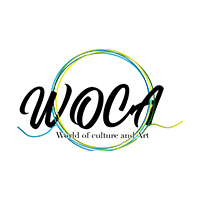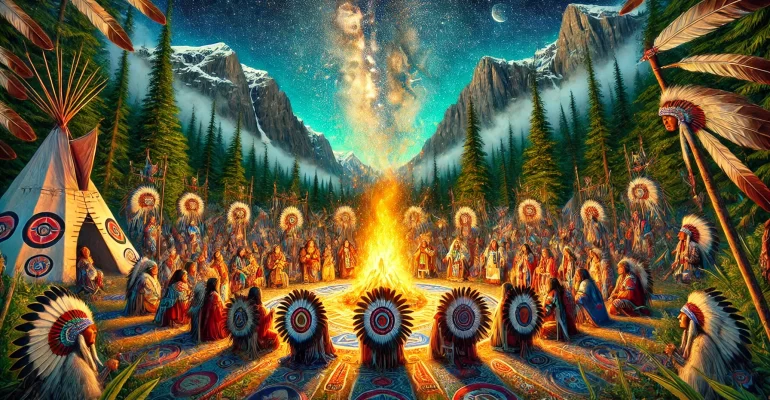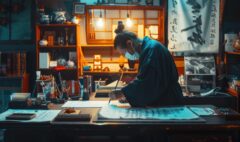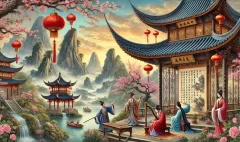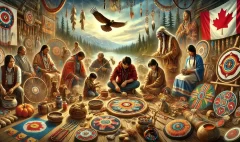Sacred Circles: The Magic and Meaning of Indigenous Ceremonies in Canada
Sacred Circles: The Magic and Meaning of Indigenous Ceremonies in Canada
Hello, curious minds and culture explorers! Today, we’re going on a special journey to learn about something really important in Indigenous cultures across Canada: Indigenous Ceremonies! These aren’t just parties or events – they’re like magical moments that bring people together, connect them to their spiritual beliefs, and mark big moments in life. And guess what? They’re also filled with amazing art and beautiful crafts! It’s going to be an exciting adventure, so let’s get started!
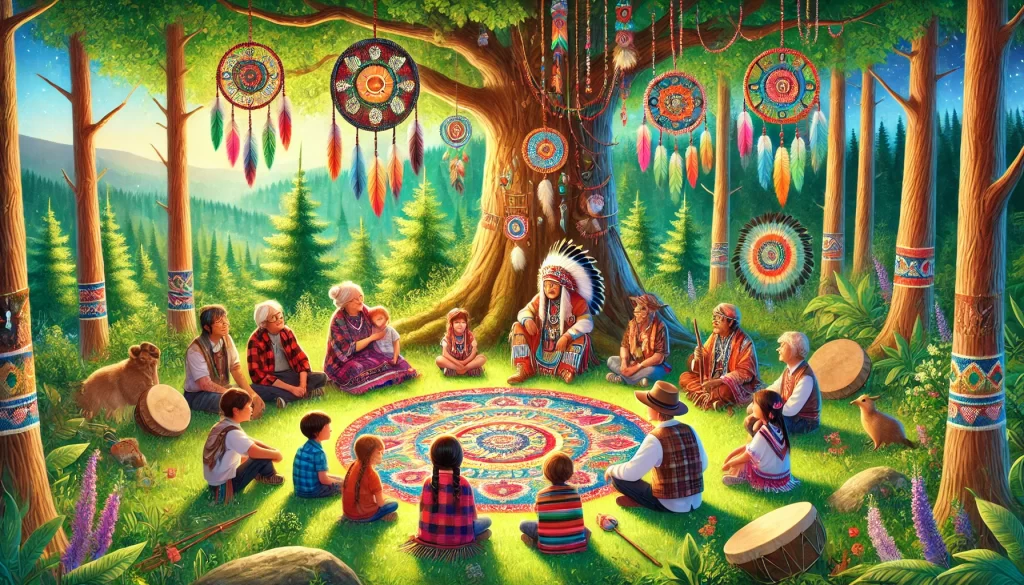
What Are Indigenous Ceremonies?
Imagine a special time and place where everyday life pauses, and something extraordinary happens. That’s what a ceremony is like for Indigenous Peoples. It’s a time when people come together to honor traditions, celebrate important moments, or connect with the spiritual world. “Ceremonies are the heartbeat of our cultures,” explains Elder Sarah Eaglefeather of the Cree Nation. “They remind us who we are, where we come from, and how we’re connected to everything around us. And in every ceremony, our art and crafts play a big role in telling our stories and honoring our traditions.”
Different Types of Indigenous Ceremonies
There are many kinds of ceremonies in Indigenous cultures. Here are a few examples:
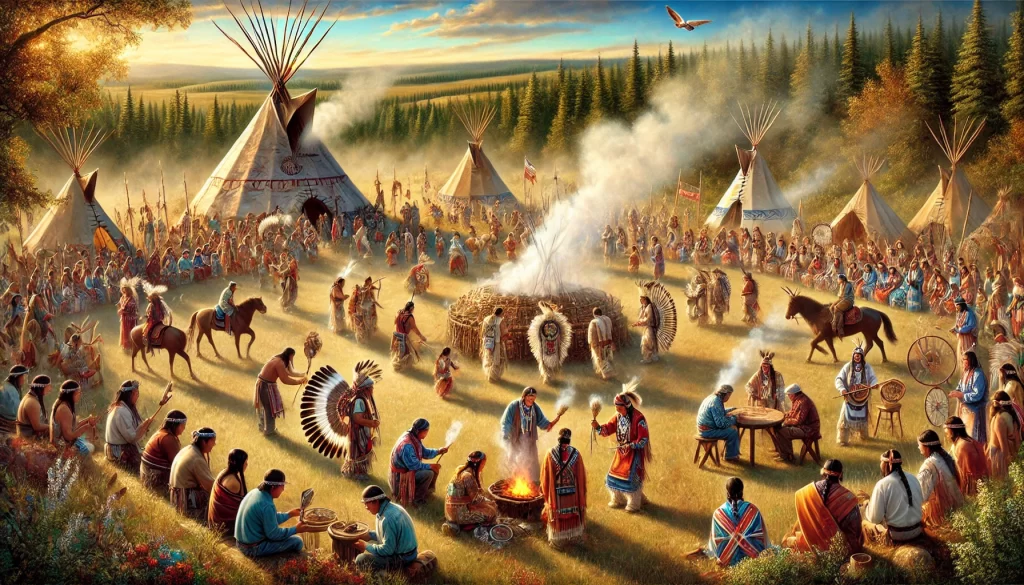
1. Smudging: A cleansing ceremony using sacred smoke from herbs like sage or sweetgrass.
2. Powwows: Big gatherings with dancing, singing, and celebrating culture.
3. Sweat lodge: A healing ceremony in a dome-shaped structure where people pray and purify themselves.
4. Naming ceremonies: When a person receives their traditional name.
5. Sun Dance: A ceremony of renewal and sacrifice in some Plains cultures.
“Each ceremony is like a different song in the big music of our traditions,” says Mike Thundercloud, a young Anishinaabe cultural teacher. “They all have their own rhythm and meaning. And just like music needs instruments, our ceremonies need special art and crafts to help them come alive.”
Art and Craft in Indigenous Ceremonies
Almost every Indigenous ceremony involves some form of art or craft. These aren’t just decorations – they’re important parts of the ceremony itself. Here are some examples:
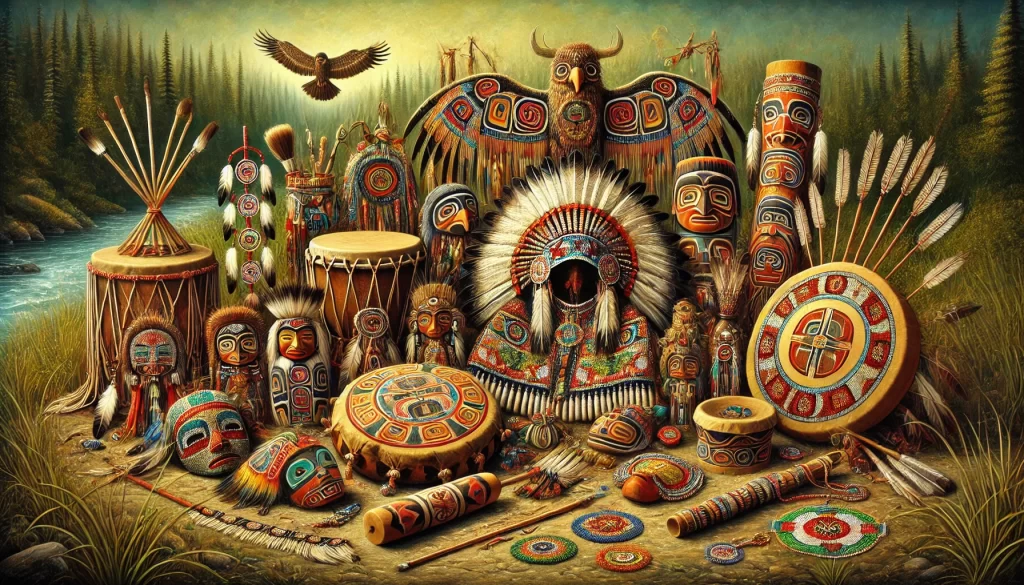
1. Regalia: The beautiful outfits worn during ceremonies, often handmade with intricate beadwork, quillwork, or appliqué.
2. Drums: Hand-crafted and painted with symbolic designs, used in many ceremonies for music and to represent the heartbeat of Mother Earth.
3. Masks: In some cultures, carved wooden masks are used in ceremonial dances to represent spirits or ancestors.
4. Medicine bundles: Small pouches containing sacred items, often decorated with beadwork or quillwork.
5. Ceremonial pipes: Carved and decorated pipes used in prayer ceremonies.
“Creating art for ceremonies is a ceremony itself,” explains Lisa Morningstar, a Métis artist. “When I’m beading a piece of regalia or painting a drum, I’m putting prayers and good thoughts into every stitch and brush stroke. The art becomes a vessel for our intentions and beliefs.”
Building Strong Communities for Indigenous Ceremonies
One of the super important things about ceremonies is how they bring people together. It’s like they’re the glue that holds communities tight! Here’s how ceremonies help build strong communities:
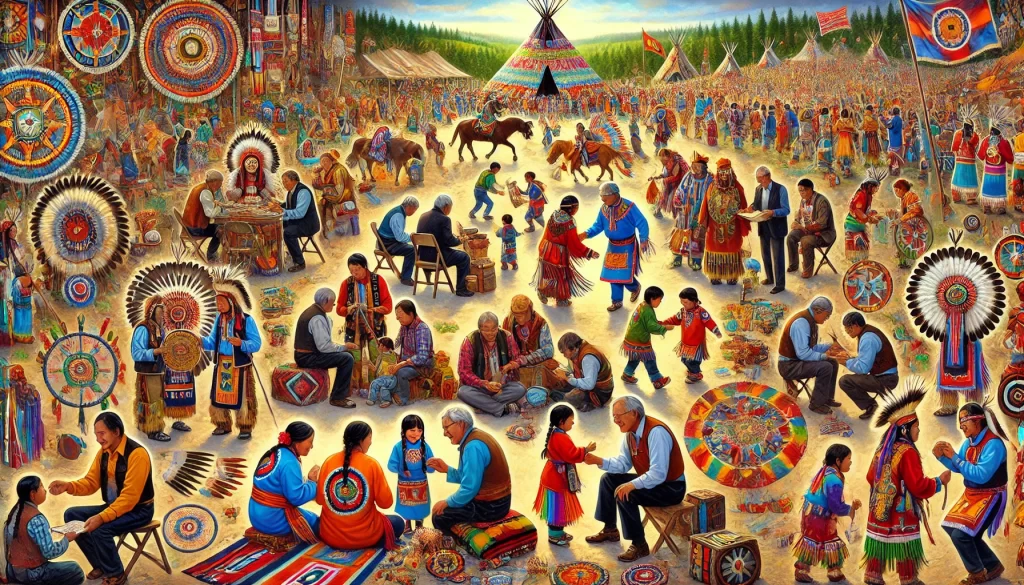
1. Teamwork: Many ceremonies need lots of people to work together to prepare and perform them.
2. Sharing knowledge: Elders teach younger people about traditions during ceremonies, including how to create ceremonial art and crafts.
3. Solving problems: Some ceremonies are times when the community can discuss issues and make decisions.
4. Celebrating together: Joyful ceremonies like powwows bring people together to have fun and be proud of their culture.
“When we come together for ceremony, we’re not just individuals anymore,” shares David Ravenwing, a Mi’kmaq community leader. “We become one big family, supporting each other and sharing in something special. And when we create art for ceremonies together, it’s like we’re weaving our community bonds tighter with each bead and feather.”
Art Workshops and Ceremony Preparation
Many communities hold special art workshops as part of preparing for ceremonies:
– Regalia-making classes where people learn to sew, bead, and decorate ceremonial clothing.
– Drum-making workshops where participants learn to stretch hides over wooden frames and decorate them.
– Basket-weaving sessions to create containers for ceremonial items or offerings.
– Face-painting classes to learn traditional designs used in certain ceremonies.
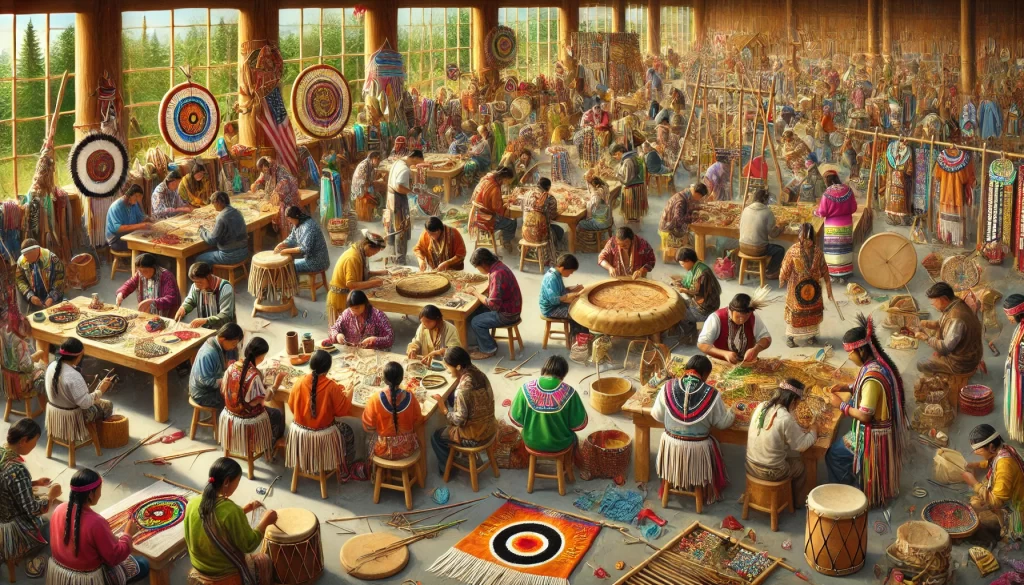
“These workshops are about more than just making things,” explains youth leader Jamie Littlefeather. “They’re where we share stories, learn our history, and strengthen our connections to each other and our culture. The art we create carries all of that into the ceremony.”
Connecting with the Spiritual World
For many Indigenous Peoples, ceremonies are a way to talk with the Creator, ancestors, and the spirits of nature. It’s like opening a door to the invisible world that surrounds us. And guess what? Art and crafts are often the key to that door! Here are some ways ceremonies and art create spiritual connections:
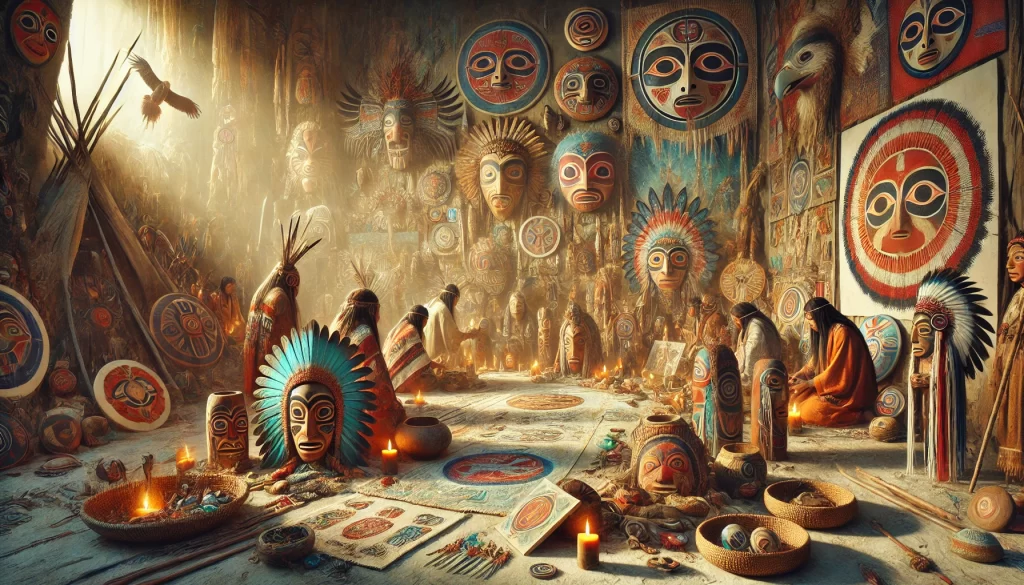
1. Sacred symbols: Many ceremonial artworks include symbols that represent spiritual concepts or beings.
2. Spirit masks: In some cultures, specially carved and painted masks are believed to embody spirits during ceremonies.
3. Offerings: Handmade items like woven baskets or beaded pouches are used to hold offerings to the spirit world.
4. Vision boards: Some ceremonies involve creating artwork to represent spiritual visions or goals.
“In our ceremonies, every color, pattern, and material has meaning,” says Elder Tom Bearwalker. “When we wear our regalia or use our ceremonial items, it’s like we’re putting on the language of the spirit world. Our art helps us speak to the unseen.”
The Role of Nature in Ceremonial Art
Nature plays a super important part in many Indigenous ceremonies, and this is reflected in the art and crafts used:
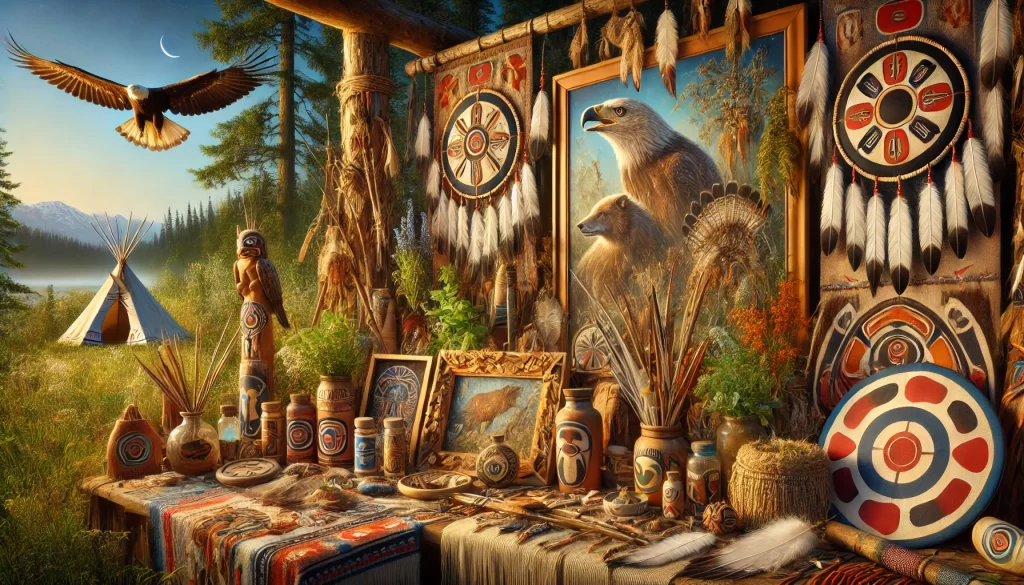
– Natural materials: Many ceremonial items are made from materials like wood, bone, feathers, porcupine quills, and plant fibers.
– Animal designs: Artwork often features animals that have spiritual significance, like eagles, bears, or whales.
– Plant medicines: Sacred plants like sage, sweetgrass, cedar, and tobacco are not only used in ceremonies but often depicted in art.
– Seasonal themes: Some ceremonial art changes with the seasons, reflecting the cycles of nature.
“When we gather materials for our ceremonial art, it’s a ceremony in itself,” explains Maria Skyriver, an Inuit artist. “We give thanks to the plants and animals that provide for us, and we only take what we need. This respect for nature shows in every piece we create.”
Marking Life’s Big Moments About Indigenous Ceremonies
Ceremonies are like special bookmarks in the story of life. They help people recognize and celebrate important moments and changes. And guess what? Each of these ceremonies often has its own special art and crafts! Here are some ceremonies that mark different life stages and the art associated with them:
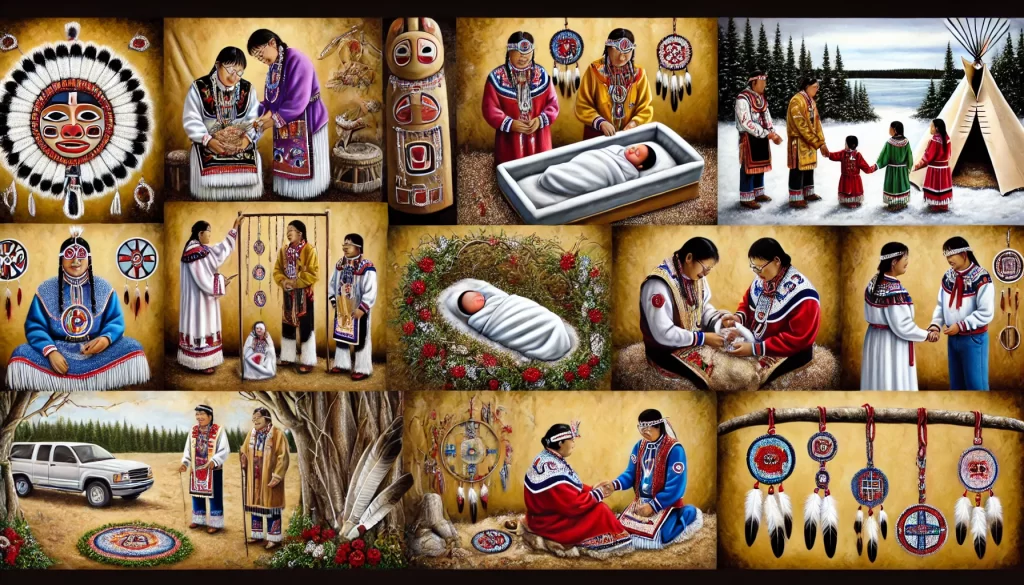
1. Birth: Welcoming ceremonies for new babies often include gifting of specially made baby moccasins or cradleboards.
2. Coming of age: Young people might receive their first piece of traditional regalia or learn to make a special item like a drum or medicine bag.
3. Marriage: Wedding ceremonies might involve the exchange of handmade gifts or the creation of a ceremonial blanket by both families.
4. Death: Memorial poles, specially decorated urns, or beaded memorial pictures might be created to honor those who have passed on.
5. Seasonal changes: Masks, rattles, or special regalia might be made for ceremonies marking the change of seasons.
“Our ceremonial art is like a visual history of our lives,” says Robert Wolfrunner, an Indigenous art historian. “Each piece tells a story of an important moment, carrying memories and teachings that can be passed down through generations.”
Keeping Artistic Traditions Alive
In today’s world, keeping ceremonial art traditions alive is an important part of maintaining cultural practices:
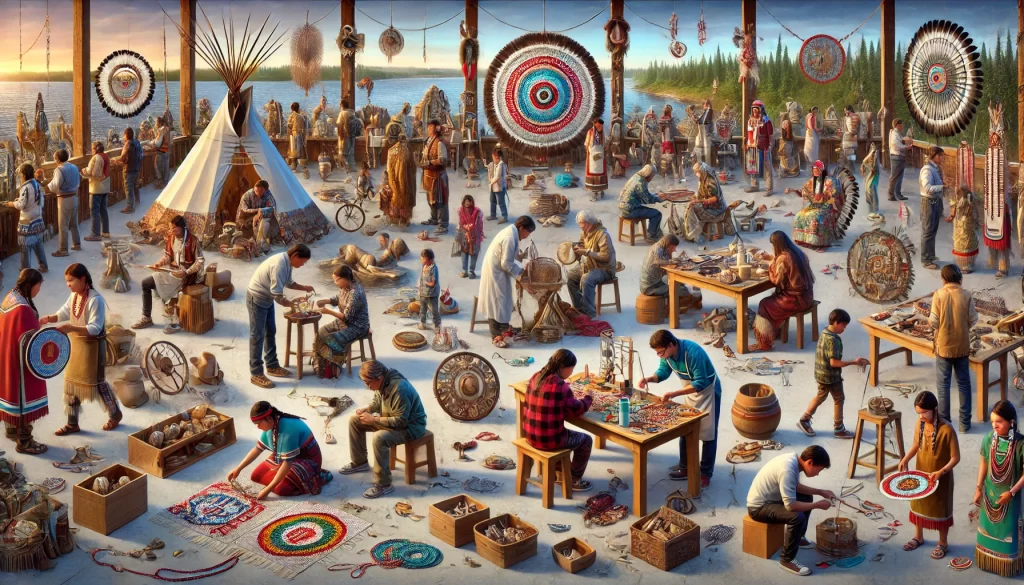
– Teaching young people: Elders and artists are sharing traditional techniques for creating ceremonial art and crafts.
– Adapting materials: While honoring traditional methods, some artists are finding new materials that are more readily available in urban settings.
– Documenting processes: Some communities are creating videos or books to record the steps of making traditional ceremonial items.
– Innovating designs: Artists are finding ways to incorporate contemporary themes into traditional ceremonial art forms.
“Our ceremonial art is always evolving, just like our cultures,” explains Lisa Thunderheart, a young Indigenous fashion designer who creates modern regalia. “We’re finding new ways to express our traditions while staying true to their spirit. It’s like painting with one foot in the past and one in the future.”
Respect and Understanding About Indigenous Ceremonies
It’s super important to remember that many Indigenous ceremonies and the art associated with them are sacred and private. They’re not shows or entertainment for outsiders. Here’s how we can all show respect for Indigenous ceremonial art:
1. Don’t touch or try on ceremonial regalia or objects without permission.
2. Ask before taking photos of ceremonial art, and respect if you’re told no.
3. Learn about the meaning behind ceremonial art instead of just focusing on how it looks.
4. Understand that some ceremonial items are only for use by specific individuals or community members.
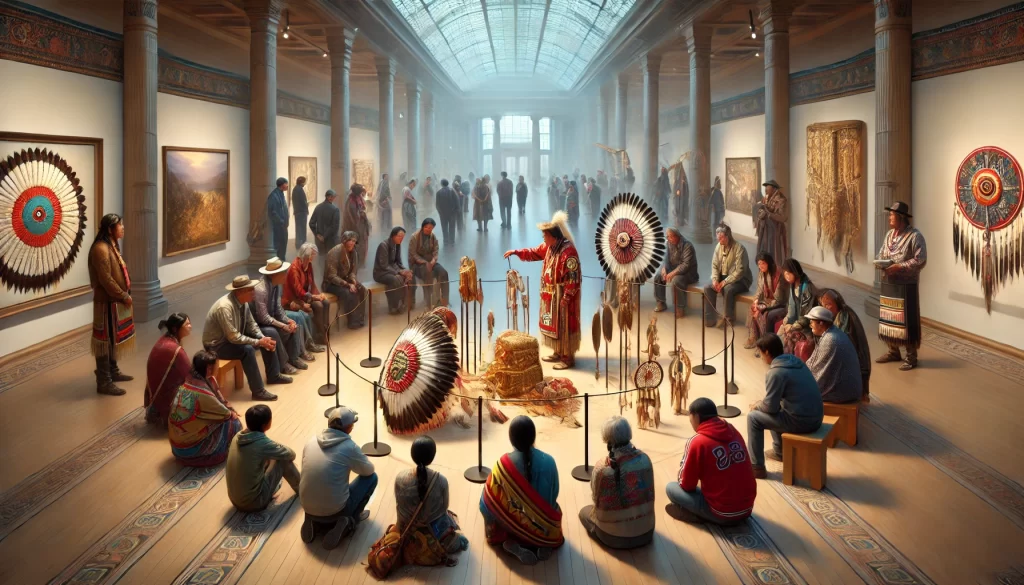
“We’re happy to share some of our artistic traditions,” explains Elder Mary Featherstone. “But it’s important for everyone to understand that our ceremonial art is not just for decoration. Each piece carries spiritual significance and cultural knowledge that deserves respect.”
Fun Ways to Learn More About Indigenous Ceremonies
Want to understand more about Indigenous ceremonies and the art associated with them? Here are some respectful ways to learn:
1. Visit museums that work with Indigenous communities to respectfully display ceremonial art.
2. Attend public events like powwows that welcome visitors and often include demonstrations of ceremonial crafts.
3. Take part in Indigenous-led workshops on traditional art forms (but remember that some techniques might be reserved for ceremonial use).
4. Read books by Indigenous authors about their artistic and ceremonial traditions.
5. Watch documentaries made by Indigenous filmmakers about their ceremonies and associated art forms.
6. Support Indigenous artists by purchasing their non-ceremonial artwork and learning about their inspirations.
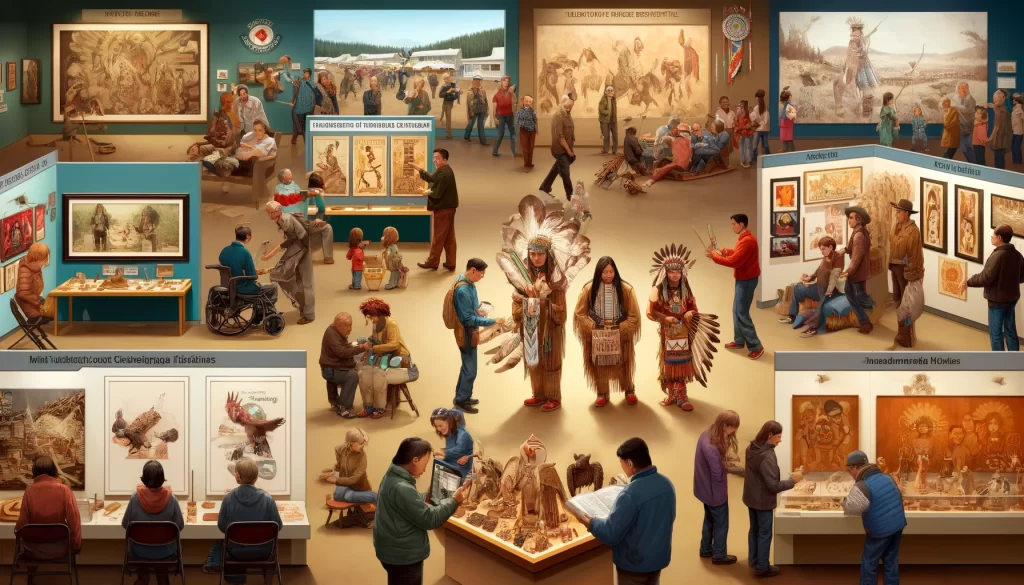
Remember, learning about ceremonial art is not the same as using it or copying it. Always be respectful and follow the guidance of Indigenous leaders and artists.
Wrapping Up: The Artistic Circle of Ceremony
Indigenous ceremonies and the art that goes with them are like beautiful, intricate circles that connect people, nature, and the spirit world. They’re a reminder that life is full of creativity, meaning, and wonder. The next time you see a piece of Indigenous art, remember that you might be looking at more than just a beautiful object. It could be a key to understanding rich ceremonial traditions that have been keeping cultures strong and communities connected for thousands of years.
Now it’s your turn! Have you ever seen Indigenous ceremonial art in a museum or at a public event? What impressed you most about it? Share your thoughts and questions in the comments below. Let’s keep learning together about the amazing world where art and ceremony come together in Indigenous cultures across Canada!
